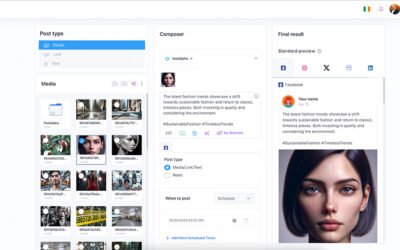Emotions play a crucial role in social media engagement. Understanding and making sense of your audience’s emotions is essential for building meaningful connections. Facebook recognises the importance of emotions in online interactions so Facebook has introduced a feature called “Reactions” that allows users to express their emotions in response to social media posts.
In this guide, we will explore what Facebook Reactions are, how they can be used effectively, and their impact on user engagement.
Exploring Facebook Reactions
What are Facebook Reactions?
Facebook Reactions are an extension of the “Like” button, offering users a more nuanced way to express their emotions. In addition to the familiar thumbs-up “Like” reaction, Facebook now provides six additional reactions: “Love,” “Haha,” “Wow,” “Sad,” and “Angry.” Each reaction represents a different emotional response that users can choose when reacting to a post. These reactions enable users to convey their feelings more accurately and provide marketers with valuable insights into the emotional impact of their content.

Where to find Facebook reactions?
Locating Reactions on a post is simple. When scrolling through your Facebook news feed, you will notice the reactions below each post. They appear as small icons just below the content, allowing users to react quickly. On the Facebook app, the reactions can be accessed by long-pressing the “Like” button on a Facebook post. This reveals a list of all the reactions, and users can choose the one that best represents their emotional response.
The meaning behind Facebook reactions
By offering a range of reactions beyond a simple “Like,” users can better convey their true feelings towards a post. These reactions have implications for both the user’s news feed and Facebook’s algorithm. The types of reactions a post receives can influence the content that appears in a user’s news feed, as Facebook aims to prioritize posts that generate meaningful interactions. Similarly, Facebook takes reactions into account when determining the visibility of posts in users’ news feeds.
How to use Facebook reactions effectively
Facebook reactions can be a powerful tool for businesses to understand their audience’s feelings and preferences. By analysing the reactions received to their posts, businesses can gauge the emotional impact of their content and tailor future strategies accordingly. To encourage users to react to posts, it is essential to create compelling and engaging content that elicits emotional responses from Facebook users. Visuals, captions, and storytelling can all play a role in eliciting reactions from the audience. The more reactions a post receives, the higher its engagement potential.

The impact of Facebook reactions on user engagement
Facebook reactions play a significant role in driving meaningful interactions. While the number of reactions to a post is not the sole measure of success, the types of reactions received can provide valuable insights. For example, a post that elicits a high number of “Love” reactions suggests a strong emotional connection with the audience. Businesses can track and analyse the reactions received on their posts to understand the emotional impact of their content and make informed decisions about future strategies. Additionally, successful brands have utilised Facebook reactions to create engaging campaigns that resonate with their audience’s emotions, resulting in increased brand loyalty and customer satisfaction.
Unveiling the Insights Behind Facebook Reactions
Facebook reactions and audience emotions
Facebook reactions provide valuable insights into the emotions of your audience. By analysing the reactions to your posts, you can gain a deeper understanding of how your content impacts different emotions. Each reaction represents a specific emotional response from users, allowing you to tailor your content strategies to elicit the desired emotional reactions.
For example, if you notice that your audience predominantly reacts with the “love” reaction to your posts, it indicates that your content resonates with them on an emotional level. This information can help you create more content that evokes similar positive emotions.
Understanding the impact of your content on different emotions is crucial for effective audience engagement. By utilising Facebook reactions effectively, you can create a more emotionally connected relationship with your audience, which can lead to increased brand loyalty and advocacy.

Understanding the distribution of reactions
When analysing Facebook reactions, it’s important to take note of the proportions of different reactions to a post. By understanding the distribution of reactions, you can identify patterns and trends that provide valuable insights into your audience’s preferences and emotional responses.
For example, if you consistently receive a high number of “haha” reactions to your humorous posts, it indicates that your audience appreciates and enjoys this type of content.
Adjusting your content strategies based on the audience’s preferred reactions can help you maximize engagement. For instance, if you notice that your audience rarely reacts with the “sad” reaction, it might be an opportunity to reevaluate the tone and messaging of your content to ensure it aligns with their emotional preferences.
The role of negative reactions
While positive reactions are desirable, it’s essential to address negative reactions such as “angry” or “sad” reactions. Negative reactions provide valuable feedback about the aspects of your content that may not resonate with your audience. It’s important to view negative reactions as opportunities for improvement and to carefully manage your brand’s reputation on Facebook.
When faced with negative reactions, it’s crucial to respond promptly and empathetically. Addressing concerns and providing solutions can help turn angry reactions into positive engagement opportunities. By actively listening to your audience’s feedback and taking appropriate actions, you can demonstrate your commitment to customer satisfaction and build stronger relationships with your audience.
Harnessing the power of positive reactions
Positive reactions such as “love,” “haha,” and “wow” can have a significant impact on brand perception and loyalty. These reactions indicate that your content has successfully evoked positive emotions and resonated with your audience. Leveraging these positive reactions can help create positive brand associations and reinforce a favourable brand image.
To generate more positive reactions, it’s important to create content that is emotionally compelling and aligns with your audience’s preferences. Consider incorporating storytelling elements, humour, or inspirational messages to evoke positive emotions in your audience. By consistently delivering content that elicits positive reactions, you can strengthen the emotional bond with your audience and cultivate brand loyalty.

Optimising Facebook Reactions for Marketing Success
Incorporating reactions into content creation
One of the key strategies for optimising Facebook reactions for marketing success is to incorporate reactions into content creation. By understanding the types of posts that generate the most reactions, marketers can tailor their content to encourage more engagement.
Social media posts that evoke strong emotions tend to encourage users to react to a post. This can include content that is funny, heartwarming, or thought-provoking. By crafting captions and visuals that elicit emotions, marketers can increase the likelihood of users reacting to their posts.
Using reactions for audience segmentation
Facebook reactions can also be used for audience segmentation. By analysing the dominant reactions of different segments within the audience, marketers can tailor their marketing strategies to resonate with specific audience emotions.
For instance, if a particular segment of the audience predominantly reacts with love and haha, it suggests that they enjoy lighthearted and humorous content. Businesses can then personalise their content to cater to this segment’s preferences, resulting in a stronger emotional connection and higher engagement.

Analysing reactions for deeper insights
It is crucial to analyse reaction data for deeper insights. Various tools and methods are available for tracking and analysing reaction data, allowing businesses to extract valuable insights.
By studying the patterns and trends in reactions, businesses can gain a better understanding of their audience’s emotions and preferences. They can identify which types of content elicit the most positive reactions and adjust their marketing strategies accordingly. This data-driven approach enables marketers to optimize their content and enhance audience engagement.
Monitoring and responding to reactions
Actively monitoring reactions to posts is essential for marketing success. Businesses should regularly check their posts to see how users are reacting and engage with the audience effectively.
Responding to reactions shows that the brand values and appreciates user feedback. It provides an opportunity to address any concerns or questions users may have and can help improve brand perception and customer satisfaction. By using reactions as a feedback mechanism, businesses can continuously improve their strategies and better meet the needs of their audience.

Conclusion
Facebook Reactions play a significant role in understanding and engaging with the audience’s emotions. By leveraging the power of reactions, businesses can drive meaningful interactions and improve their marketing strategies. Optimizing Reactions for marketing success involves incorporating reactions into content creation, using them for audience segmentation, analyzing reactions for deeper insights, and monitoring and responding to reactions.
The evolving landscape of social media emphasizes the importance of understanding and utilising reactions to connect with audiences on a more emotional level. By tapping into the different emotions expressed through reactions, businesses can create content that resonates with their target audience and elicits positive engagement.
As social media continues to evolve, the role of reactions in shaping user engagement will only become more significant. Therefore, it is essential for businesses to stay informed about the latest trends in Reactions to ensure their marketing strategies remain effective and relevant.
How to Show as offline on Instagram
Heads up: Your Instagram buddies can see when you’re online! Imagine this: You’re chilling, scrolling through Reels, when a friend starts bombing you with not-so-funny memes. The endless pinging is enough to drive anyone mad. Worse still, they can see you’re online...
What’s new in V2: A look at the new features launched in Feedalpha
First, a note from the CEO At its core, Feedalpha has always been a content curation and social media management platform that helps users stay updated with the latest trends and topics relevant to their industry or personal interests. We grew the business to 11,000 +...






